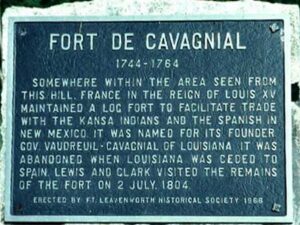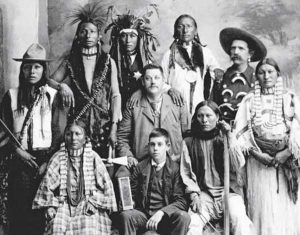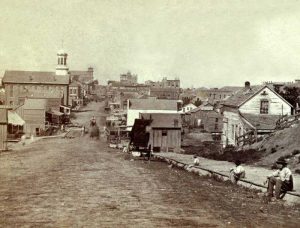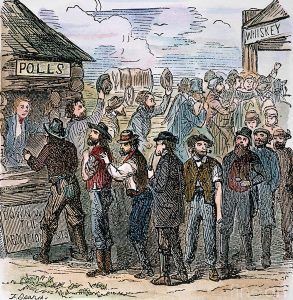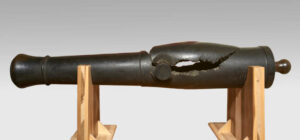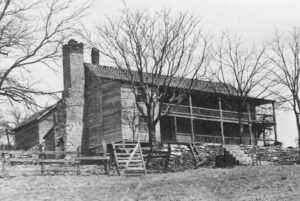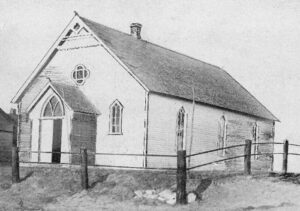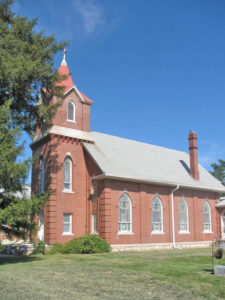Kickapoo, Kansas, one of the oldest towns in Leavenworth County, was first called Kickapoo City. The town is extinct today.
The first European settlers in the area were the French, who established Fort de Cavagnial in 1744. Established before the Louisiana Purchase, it was built by a French trader, Joseph Deruisseau, who, on August 8, 1744, was granted a monopoly to trade with the Indians along the Missouri and Kansas Rivers. The fort, which was no more than 80 feet square, was established to ensure France’s claim to the region and to facilitate and protect the fur trade with the natives. The fort continued to be utilized until France abandoned the fort after Louisiana Territory was ceded to Spain in the treaties concluding the French and Indian War. Lewis and Clark would later pass by the ruins of the old fort on their journey west in 1804.
Reverend Jerome C. Berryman established a Methodist mission among the Kickapoo Indians in the fall of 1833 in the northeast part of Leavenworth County.
The same year, Father Van Quickenborn and Father Hoecken established a Catholic mission in the vicinity to work with the area Indians. When a Kickapoo chief attended a Mass, he was so impressed that he requested Father Van Quickenborn send a priest to live with the tribe. Father Van Quickenborn then secured permission and received a $1,000 government grant to establish a mission building in the area. He then began to build the Sacred Heart Church, the first church in Kansas. In 1834, the Catholics started a manual labor school there. However, the Kickapoo did not take kindly to the idea of working, and the school was practically abandoned.
In 1844, Major Robert Wilson established a trading post near the mission. The trading post was a short distance west of the Salt Creek bridge, near the house he built afterward. In 1852, he sold out to Major M. P. Rively and became the sutler at Fort Riley.
In 1845, Major William F. Dyer, an agent of the Kickapoo Indians and afterward a trader among them, settled with his family, settled in the area, and remained there for nine years.
Reverend Joel Grover, an Indian missionary, settled here in 1851 and died there three years later.
Kickapoo City was established on what was once part of the Kickapoo Indian Reservation by Weston and Platte County, Missouri citizens, who intended it to rival Leavenworth. Even before Leavenworth existed, the area was a political rival of Fort Leavenworth. This is evident from the fact that a convention was held in the village on September 20, 1853, which arranged for electing a delegate to Washington, to urge upon Congress the organization of the new Territories of Nebraska and Kansas. It was not held at Fort Leavenworth because it was deemed desirable that the demonstration should not appear to have the countenance or cooperation of the officers and soldiers. At that time, there was just one trading house in the village.
On June 10, 1854, the first squatters’ meeting in the county and the Territory was held in Major Rively’s store. D. A. Grover was elected Register of Claims and Malcolm Clark, Marshal. Among the early settlers of the city and township were William Finley, John Freeland, chairman of the County Board for many years and foremost in getting its finances into shape; Jesse Connell, farmer, State Senator, and businessman; George O. Sharp, who ran Captain Dennis’s sawmill, a man of affairs, and present postmaster; Isaac Cody, father of “Buffalo Bill,” who had a small farm, a hotel, and store; Lawrence Kennedy, Mayor of “Pleasant Ridge,” a village situated on the bluff, three miles west of Salt Creek Valley; Merrill Smith, a large Government Freighter, hotel keeper and farmer, who settled in 1854 near Salt Creek bridge; David Harley, builder of the Eight-Mile House; J. B. Crane and H. B. Gale, settlers of 1854, in the northwestern part of the township.
The Kickapoo Town Company surveyed and laid out the town site in July 1854 on a site containing 309 acres. Josiah Elliott was elected as Kickapoo City’s first mayor. A large portion of the township, including the townsite, was open to pre-emption under the laws of the United States, and for this reason, it was supposed that Leavenworth would find it hard to compete with her rival.
The first thing to be done after the town company regularly surveyed the site was to keep the claims of would-be settlers from the grasp of “jumpers.” Captain J. W. Martin, afterward captain of the celebrated “Kickapoo Rangers,” had made a claim and returned to his home in Liberty, Missouri, to bring back his family. His claim was jumped while he was away, and he employed H. Miles Moore, a personal friend, to go to Salt Creek Valley and argue his case before the Squatters’ Court. Mr. Moore won the case and accompanied Malcolm Clark, the marshal, that the “ousting” decision was enforced. The man who played the role of jumper had fled, but his wife “held the fort” and flung defiance at the law. After coaxing, threats, and force had been employed, she was finally loaded into a wagon with children and household goods and departed. She threatened to burn the cabin, however, as soon as the officers of the law left, and Captain Martin was obliged to place a guard of two men over his property until he could get his family over from Missouri. During the first days of November, emigration was quite brisk towards Kickapoo.
A gentleman of Leavenworth, who was in company with other men, made a trip to Kickapoo to attend a sale of lots wrote of Kickapoo City:
“On the Missouri River at Kickapoo is a fine body of timber and prairie. The town commences at the bottom, on a strip about a quarter of a mile wide. At the upper end of town, the bluffs recede from the river, leaving the bottom in the shape somewhat of a half-moon. The town runs back on the highlands. A ravine passing through the center of the town tract affords easy access to the river, with one or two fine springs appearing along this ravine. Some energetic businessmen have taken hold of this place, who will contribute greatly towards building the town. A brisk and spirited sale took place on the premises. The lots generally brought from $30 to $70, $80, and $100 each, and one or two, we think, were as high as $110. We understand there were some 40 or 50 lots sold.”
Though early Kickapoo City seemed like the front-runner in the race for supremacy, it had its disadvantages. It was far smaller than Leavenworth, had less industry, and only one railroad line ran through Kickapoo, while Leavenworth boasted three. Leavenworth also had a riverboat landing point, while Kickapoo did not. However, it had the advantage of numerous pro-slavery “squatters” from Missouri who poured across the river. These activists were in direct opposition with the Free State citizens of Leavenworth. These new residents led to a boom in Kickapoo’s economy. A steam ferry was established between Weston, Missouri, and Kickapoo, and two steam mills were founded.
The Kickapoo Pioneer was established as the city’s first newspaper, with a decidedly pro-slavery slant. The Pioneer lasted until 1885 without the pro-slavery rhetoric of its earlier days.
The Kickapoo City post office was established on January 24, 1855, with T. D. Armond appointed the first Postmaster. The mail was taken across the river from Weston, Missouri, and Kickapoo City was, for some time, quite a distributing point for the postal service. Before long, there were grocery, dry goods and general stores, hotels, saloons, lawyers’ and doctors’ offices, and more.
In October 1855, an election was held to determine which city would become the county seat. Despite the official population being only 500, the election results showed that Kickapoo boasted a population of a little less than 1,000. Though Kickapoo lost the election, the Kickapoo Pioneer declared otherwise.
Instead, Delaware City, which sprang into existence the year of the election, won, and Leavenworth came in last. Pro-slavery supporters from Missouri also established Delaware City. However, it would only retain the county seat for a few years.
Suspecting foul play in the election results, the Kansas Legislature ordered another election in October 1857. This time, Kickapoo won with just 36 more votes than Leavenworth. Once again, foul play was suspected, and a third election was held in January 1858. To ensure no fraudulent votes were cast, Governor James Denver dispatched troops from Fort Leavenworth under the command of the U.S. Marshal to oversee the polls. Although the troops counted 400 votes cast, the returns showed the number cast was in the tens of thousands. Proving fraud, the case went into litigation. Eventually, Leavenworth won the county seat permanently. Delaware City disappeared within a couple of years. Kickapoo also began to lose influence as popular opinion in Kansas began to lean more positively toward becoming a Free State.
On January 5, 1858, a party of 50 or 60 Free-State men of Leavenworth went to Kickapoo City, and while the pro-slavery men were sleeping, carried off a six-pound brass cannon called “Old Kickapoo,” which had been stolen from the Liberty, Missouri arsenal. It was taken by a group of Free-State men under the leadership of Deputy U.S. Marshal Cowell. He entered Kickapoo City on the pretext of serving writs on several citizens of Kickapoo for violating the election laws. However, the excursion was a jolly sort of a “lark,” but the people of Kickapoo were vexed at the loss of their cannon, which had been a source of amusement for several years.
The next day, the Free-state boys of Leavenworth, with drums beating and flags flying — some of the victorious army on foot, some on horseback, paraded the streets, dragging glorious “Old Kickapoo” after them. Kickapoo citizens then held a meeting, making them out as a blood-thirsty mob, breaking open dwellings and stores, and trying to draw innocent citizens into a fight. The spirit of the proceedings was that “Old Kickapoo” must be recaptured — “peaceably if we can, forcibly if we must.” However, “Old Kickapoo” was placed in hiding in Leavenworth.
Kickapoo City began to decline as many Missourians returned to their home state, leaving a large section of the town deserted. Soon flood water reclaimed the area on the river bank. However, the steam and sawmills and the ferry continued operations.
When Kansas became a state on January 29, 1861, the citizens of Leavenworth pointed the Old Kickapoo cannon toward Missouri. They loaded the barrel with copies of the pro-slavery laws enacted a few years before at the first territorial capitol. The documents were sent flying across the Missouri River. Today, the cannon is in the hands of the Kansas Historical Society at the Kansas Museum of History in Topeka, Kansas.
Kickapoo returned to the spotlight in the 1870s and 1880s due to one of its most prominent citizens and his world-famous son. Isaac Cody was one of the earliest settlers in the Salt Creek Valley region, arriving in 1854. He established a hotel, farm, and a small store outside town. So popular was his hotel in political circles that it became known as “Cody’s Precinct,” a title it retained until it was accidentally destroyed by fire. If Isaac Cody was popular, he didn’t hold a candle to his son, William F. “Buffalo Bill” Cody, the famous Indian fighter and entertainer. Buffalo Bill visited the family homestead numerous times, even after his parents died.
The limelight was short-lived, however. More and more people began leaving both the town and township of Kickapoo. Farms were sold out to others, businesses closed, the ferry ceased operation, and the population continued to fall. The land office closed in 1875, causing more settlers to leave.
On January 23, 1902, the post office name was changed to Kickapoo.
By 1910 there were only 200 residents living in town, down from the 1,000 of 60 years previous. At that time, Kickapoo had a money-order post office, several general stores, churches, and a public school.
Kickapoo’s post office closed on August 31, 1920.
Today there is nothing of Kickapoo town except a small neighborhood of privately owned homes, the Sacred Heart Catholic Church, which is only used for midnight mass on Christmas Eve, and the cemetery.
Kickapoo was located on the Missouri River and the Missouri Pacific Railroad seven miles northwest of Leavenworth.
©Kathy Alexander/Legends of Kansas, updated June 2023.
Also See:
Extinct Towns of Leavenworth County
Leavenworth County Photo Gallery
Sources:
Baker, Zach; “Kickapoo, Leavenworth County,” Lost Kansas Communities
Hall, Jesse A., and Hand, LeRoy T.; History of Leavenworth County, Kansas, Historical Publishing Co., Topeka, KS, 1921Kansapedia
Kansas Post Office History
Blackmar, Frank W.; Kansas: A Cyclopedia of State History, Vol I; Standard Publishing Company, Chicago, IL 1912.
Morgan, Perl W.; History of Wyandotte County, Kansas and Its People, Lewis Publishing Company, Chicago, IL, 1911.


